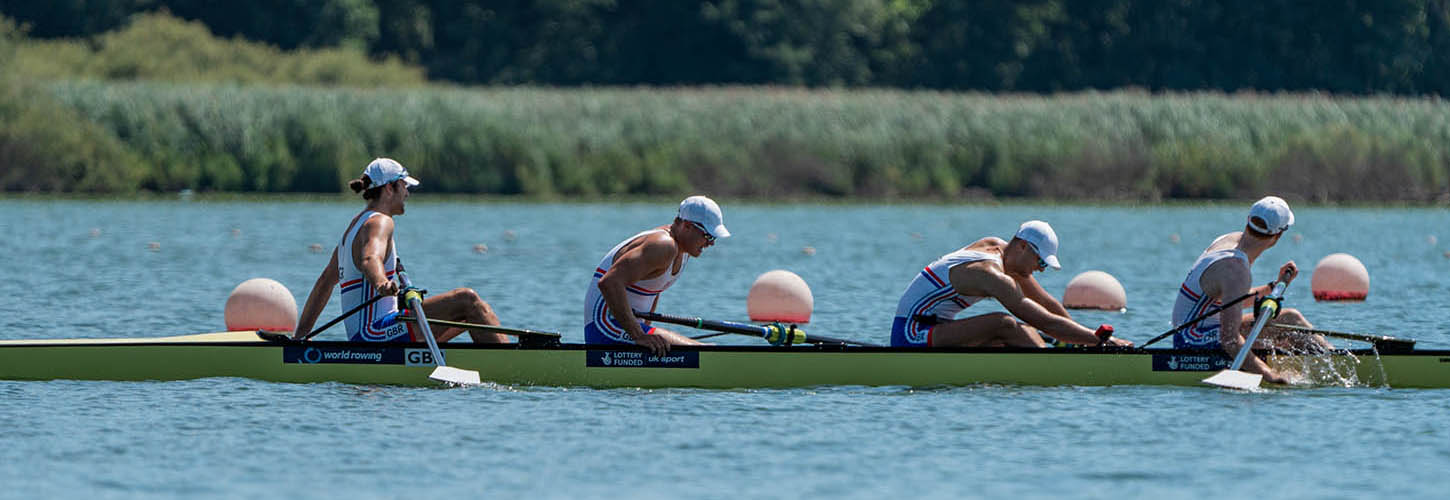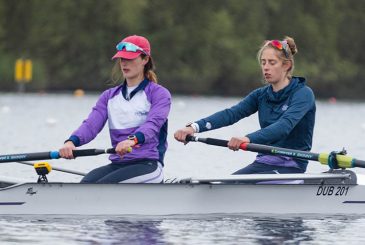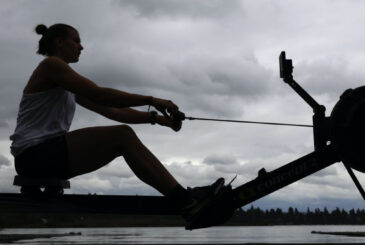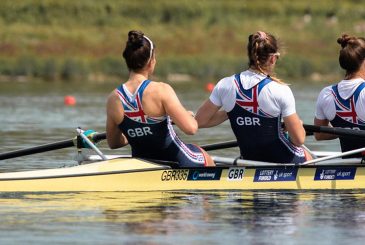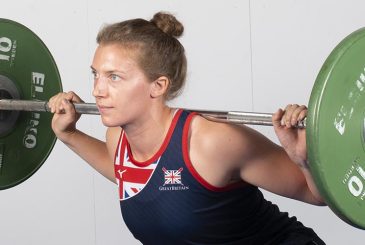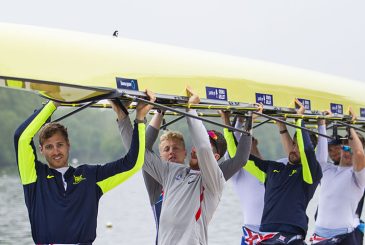In the previous article in this series, we looked at how and why using different training zones will develop your physiology for rowing. Here, we’ll explore what research with elite athletes has revealed about how much time you should spend in each training zone.
Different training intensity distributions (TIDs)
Elite endurance athletes typically distribute training in one of three distinct ways: polarized, pyramidal and threshold. Each of these methods vary the amount of Low (LIT), Moderate (MIT) and High Intensity Training (HIT) in the overall programme.
Polarized training has a majority of LIT, followed by HIT and only a small volume of MIT. Pyramidal maintains LIT as the primary zone but has more MIT than HIT. And threshold training prioritises MIT over both LIT and HIT. The names for these methods make more sense when they’re set out visually:
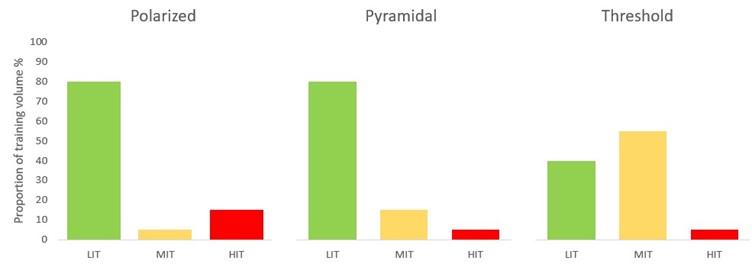
How to calculate how much training to do in each zone
Using heart rate
As an athlete, the use of heart rate and RPE can be very useful to establish which zone you’re training in.
However, as a coach, calculating the amount of time your athlete has spent in each zone is potentially very confusing depending on which method you use. Heart rate has been found to under report1 the moderate and high intensities due to heart rate lag. It can also be very disruptive if working in a crew. Using speed/pace or power, if you have access to biomechanical telemetry, can give an approximate indication that all or most of the athletes are training in the correct zone.
For example, in a week of 100k of rowing across eight sessions, if the athletes completed 8k of MIT (e.g. 30 minute rate 20 ergo) and 6km of HIT (e.g. 3 x 2000m rate 28, 30, 32), with the remainder assumed to be LIT, then the distribution training intensity by distance is 86% LIT, 8% MIT and 6% HIT (86/8/6) and therefore is using the pyramidal method.
Using session goals
Another method researchers have started to use for its ease and validity is the session goal approach. This uses the primary goal of the session to identify the training zone in which you have mainly trained. Using the same example as above, there were six LIT sessions, one MIT and one HIT, giving a percentage distribution of 75/12.5/12.5.
This method is particularly useful when doing very high intensity work (e.g. towards a race). For example, if you did your 6,000m of HIT as 4 x 500m flat out on three separate occasions during a week of 100km, that would make 3 out of eight or 37.5% of your sessions HIT. The distance-based TID method would still only recognise 6% of the programme as HIT, which may not accurately represent how intense the programme was that week in comparison to the previous example, where the 6,000m TID was all done in one session.
If you want a simple way of monitoring the training you are prescribing each session/week/year, then the session goal method will work very well and allow you to keep track of the intensity distribution as you are changing the overall volume of training (as covered in the Overview at the beginning of this series). However, if you want to be more detailed, then monitor exact distance or time spent in each zone. And if you’re an athlete then knowing how much time you’ve spent in each zone using HR or RPE is very useful (although it does require you to wear a HR monitor for every session and be sure it’s accurate).
What is the optimal training intensity distribution?
Different endurance sports may require different distributions depending mainly on the race duration and the particular sport’s nuances such as the racing start in rowing or the presence of hills in cross-country skiing and cycling. Despite this, research2 has almost exclusively found that elite endurance athletes perform either pyramidal or polarized training with a very large component of LIT (mostly over 80% but up to 95%3), for the reasons covered in the previous article.
This is true for a wide range of athletes from runners competing for two minutes4 all the way through to Tour de France cyclists5 competing for 100 hours, for the simple reason that the majority of energy is supplied through aerobic pathways. Within elite rowing, despite initial suggestions6 that the polarized distribution is the most appropriate for rowing training, research has found a mix of the two methods being employed successfully across different programmes7 and 8. For example, the extremely successful New Zealand men’s pair of Eric Murray and Hamish Bond were even found9 to have used different distributions despite being in the same crew! This was due to their spending the winter months training apart on the bike and ergometer.
Why might you change the distribution of your programme?
There are a couple of reasons: practicality and tapering. First, if you’re only able to complete a small number of sessions (e.g. one a day) then you’ll find that you’re able to intensify your training because you’ll be able to recover from these sessions more easily than an athlete completing two to three sessions a day. In this situation you may wish to change one LIT session to a MIT, for example.
The other reason for changing the distribution is during the competition period or in a taper2. Research has found that elite athletes may well reduce the MIT10 they complete as they do more high intensity work (race prep) and therefore ‘polarize the training more. The reason for reducing MIT is that the fatigue costs of doing it are outweighed by the physiological benefits during this period, whereas LIT can actively enhance recovery11 from HIT sessions. Within the GB Rowing Team there is typically pyramidal training performed during winter months and on training camps and polarized during the summer racing season.
Overall, it’s important for elite athletes to complete a very high volume of low intensity training. Alongside this you must monitor the distribution of the intensity to ensure it’s not becoming too intense, which will ultimately restrict the total volume you can complete. Then you should consider how you’re training during the different parts of the season and balance your intensity distribution accordingly.
Looking ahead
In the next article in this series of six, we’ll explore the use of training camps for the elite rower. We’ll cover what these should involve and where and when they should be held to gain the intended physiological outcomes.
References
- Sylta, Øystein. (2017). Sylta, Ø.: Endurance training organization in elite endurance athletes – From description of best practice towards individualized prescription. Doktorgradsavhandling ved Universitetet i Agder. (2017). 10.13140/RG.2.2.19966.18240. https://www.researchgate.net/publication/317235168_Sylta_O_Endurance_training_organization_in_elite_endurance_athletes_-_From_description_of_best_practice_towards_individualized_prescription_Doktorgradsavhandling_ved_Universitetet_i_Agder_2017/ (Downloaded 12 January 2023).
- Stöggl, Thomas L., Sperlich, Billy. The training intensity distribution among well-trained and elite endurance athletes, Frontiers in Physiology, 6. (2015). 10.3389/fphys.2015.00295. https://www.frontiersin.org/articles/10.3389/fphys.2015.00295 (Downloaded 12 January 2023).
- Treff Gunnar, Winkert Kay, Sareban Mahdi, Steinacker Jürgen M., Becker Martin, Sperlich Billy. Eleven-Week Preparation Involving Polarized Intensity Distribution Is Not Superior to Pyramidal Distribution in National Elite Rowers. Frontiers in Physiology, 8. (2017). 10.3389/fphys.2017.00515, https://www.frontiersin.org/articles/10.3389/fphys.2017.00515 (Downloaded 12 January 2023).
- Kenneally, M., Casado, A., & Santos-Concejero, J. (2018). The Effect of Periodization and Training Intensity Distribution on Middle- and Long-Distance Running Performance: A Systematic Review, International Journal of Sports Physiology and Performance, 13(9), 1114-1121. Retrieved Jan 12, 2023, from https://journals.humankinetics.com/view/journals/ijspp/13/9/article-p1114.xml
- A. Lucía , H. Joyos , J. L. Chicharro. Physiological Response to Professional Road Cycling: Climbers vs. Time Trialists. Int J Sports Med 2000; 21(7): 505-512. 10.1055/s-2000-7420. https://www.thieme-connect.com/products/ejournals/abstract/10.1055/s-2000-7420 (Downloaded 12 January 2023).
- Fiskerstrand, Å. and Seiler, K.S. (2004), Training and performance characteristics among Norwegian International Rowers 1970–2001. Scandinavian Journal of Medicine & Science in Sports, 14: 303-310. https://doi.org/10.1046/j.1600-0838.2003.370.x. https://onlinelibrary.wiley.com/action/showCitFormats?doi=10.1046%2Fj.1600-0838.2003.370.x (Downloaded 12 January 2023).
- Plews, Daniel & Laursen, Paul & Kilding, Andrew & Buchheit, Martin. (2014). Heart-Rate Variability and Training-Intensity Distribution in Elite Rowers. International journal of sports physiology and performance. 9. 10.1123/ijspp.2013-0497. https://www.researchgate.net/publication/261373877_Heart-Rate_Variability_and_Training-Intensity_Distribution_in_Elite_Rowers (Downloaded 12 January 2023).
- Neykov, Svilen; Zhelyazkov, Tsvetan. Load Optimization in Training the Olympic Rowing (Skiff) Champion from Beijing, 2008: Case Study. https://www.sjss.sportsacademy.edu.rs/archive/details/full/load-optimization-in-training-the-olympic-rowing-skiff-champion-from-beijing-2008-case-study-180.html (Downloaded 12 January 2023).
- Plews DJ, Laursen PB. Training Intensity Distribution Over a Four-Year Cycle in Olympic Champion Rowers: Different Roads Lead to Rio. International Journal of Sports Physiology and Performance. 2017 Sep:1-24. DOI: 10.1123/ijspp.2017-0343. PMID: 28952837. https://europepmc.org/article/med/28952837 (Downloaded 12 January 2023).
- Espen Tønnessen ,Øystein Sylta,Thomas A. Haugen,Erlend Hem,Ida S. Svendsen,Stephen Seiler. The Road to Gold: Training and Peaking Characteristics in the Year Prior to a Gold Medal Endurance Performance, July 14, 2014. https://doi.org/10.1371/journal.pone.0101796. https://journals.plos.org/plosone/article?id=10.1371/journal.pone.0101796 (Downloaded 12 January 2023).
- Seiler S. What is best practice for training intensity and duration distribution in endurance athletes? Int J Sports Physiol Perform. 2010 Sep;5(3):276-91. doi: 10.1123/ijspp.5.3.276. PMID: 20861519. https://pubmed.ncbi.nlm.nih.gov/20861519/ (Downloaded 12 January 2023).
Photo: British Rowing


